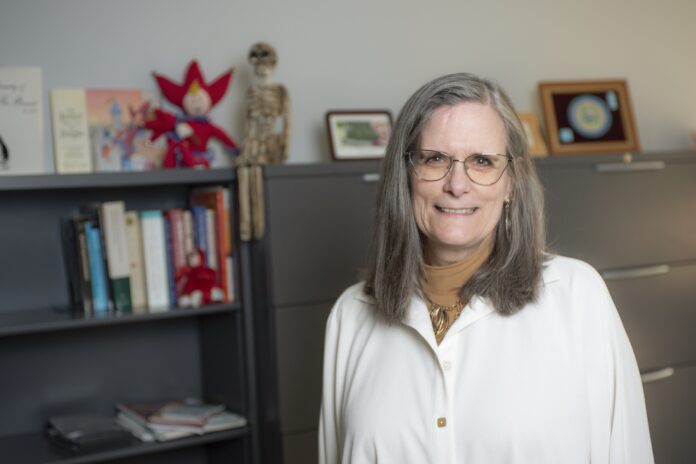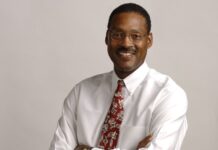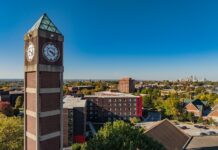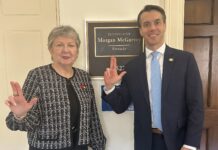
Preparing more social work students with knowledge to help their future clients and patients manage chronic or life-limiting diseases is part of Karlynn BrintzenhofeSzoc’s vision. She is the new Dr. Renato LaRocca Endowed Chair in Oncology Social Work at the Kent School of Social Work and Family Science.
She replaces Karen Kayser who served as the school’s first endowed chair for the program and recently retired. BrintzenhofeSzoc shares her personal story that led to her interest in the field, along with how her growing body of research is changing clinical care in this one-on-one with UofL News.
UofL News: How did you become interested in oncology social work?
BrintzenhofeSzoc: I became interested in oncology social work when I was a teenager, even though I didn’t realize it at the time. My mother died of breast cancer when I was 13, and it was devastating to me, to my siblings (there were nine of us), and to our dad, who became our primary caregiver. We were from 6 to 25 years of age. I decided then that I wanted to work with people who were or would experience the death of a family member from cancer. I was thinking about children who had a parent with cancer and thought that if they knew how sick the parent was and could talk to someone about it, they would be more prepared to live without the parent. I wanted to be that person to whom they could talk.
I didn’t know that social workers existed when my mother died. I learned this when I was a senior in college. I took an Introduction to Social Work course as an elective, and by the end of the semester, I knew that was how I could attain my goal of working with families preparing to or grieving the death of a parent due to cancer.
I had two field placements at Virginia Commonwealth University, where I earned a Master of Social Work degree. I was placed at a settlement house in Richmond, Virginia, the first year. I worked with children from the neighborhood and the older adults who attended the daycare center. I discovered that I didn’t like working with children but loved working with older adults. My second placement was at the Johns Hopkins Oncology Center in the outpatient clinic. Here I worked with adults who had cancer, mostly with a terminal disease, and their families. It was exactly what I wanted to do.
UofL News: Your research focuses on the experience of chronic or life-limiting disease on what is known as the BioPsychoSocialSpiritualSexualCulture (BPSSSC) aspects of individuals. Explain this, please.
BrintzenhofeSzoc: After receiving my MSW, I worked at The Johns Hopkins Hospital on the AIDS inpatient unit. During this time, I was able to apply a core concept from social work to what I was doing on the unit. This was working with individuals and families using the lens of BioPsychoSocial care. This meant that I paid attention to the biological (illness-related), the psychological (emotions, quality of life, adaptation to the illness) and the social (family relationships, social support, communication) domains of each person and not just their diagnosis of AIDS. Through this work, I realized that there was more to the individual that didn’t necessarily fit into the BioPsychoSocial domains. The other domains that I became aware of, over time and with more experience, as they almost always came with when working with people with AIDS, included spirituality and religion, sexuality and cultural issues.
Throughout my career as an academic and as a researcher, I continued to explore how all six domains, rather than just three, were present and how they played a part in moving through the trajectory of the disease. I wanted social workers to include the whole person in their practice and research, so I expanded the concept to include all the domains I had identified and that which was in the literature. So, I expanded the core concept of the BioPsychoSocial domains to the BioPsychoSocialSpiritualSexualCultural (BPSSSC) domains.
I started using the expanded concept in my teaching to highlight the importance of spirituality, sexuality and culture in working with patients and families in medical settings. This was also a way to encourage students and future social workers to include these three additional domains into their assessments, treatment plans, outcomes and research. I wanted them to ask specific questions about these sometimes taboo topics. Over the past five years, I have assembled literature that demonstrates the benefit of including these domains in social work practice. I am currently working on a manuscript presenting the BPSSSC. The importance of expanding the lens of social work has become more evident over the past two years due to the COVID pandemic and the racial unrest we have all experienced.
UofL News: How have your findings translated into clinical care?
BrintzenhofeSzoc: Following a cancer diagnosis, cancer patients and their family members experience a range of psychosocial distress. I was an integral member of a research team that explored the relationship between distress based on cancer sites, or where the cancer was in the body. We published an article in 2001 with the outcomes of this study. The dataset was made up of 4,496 patients with 14 different cancer diagnoses. This study had the largest sample size at the time and continues to be one of the largest sample sizes used in distress research. The outcome reported was that the prevalence of distress among all patients regardless of cancer site was 35.1%. The prevalence of distress differed by cancer site, ranging from 29.6% among those with gynecological cancer to 43.4% among those with lung cancer.
These findings were translated into clinical practice directly through changes made by the accrediting body of cancer centers, the American College of Surgeons Commission on Cancer. In 2015 the [commission] added the requirement that all new patients seen in a cancer center be screened for distress. The mandate further states that patients who report high distress be offered an appropriate intervention. Further, annual data was to be collected and reported on the number of patients screened, the percent of high distress and the number of those who were offered intervention and accepted it. This is one example of how my findings have translated into clinical care.
I also have developed and tested several measures for use with people with chronic or life-limiting diseases. This included the following measures: Healing Experiences in All Life Stressors, Profile of Adaptation to Life among medically ill populations, Satisfaction with Life Domains Scale for breast cancer and the BSI-18. Clinicians and researchers use these measures to increase our understanding of outcomes across the BPSSSC domains and those amenable to using evidence-based practices that focus on improving these outcomes.
UofL News: You have experience as a clinical social worker at the Johns Hopkins Oncology Center. How did this and other work in the clinical setting influence your future research?
BrintzenhofeSzoc: When I graduated, there were no jobs at Hopkins Oncology Center, so I applied for and was hired to work on the AIDS unit at the Johns Hopkins Hospital. It was just right for me. I was able to work with adults, mostly young adults, who had a diagnosis of AIDS. Most of the people I worked with died during my two years there. It was amazing to have the honor of working with people who knew they were dying of AIDS. I also worked with their partners, family members and friends. One of the most rewarding aspects of this job was working with the medical residents and fellows who rotated through the unit and being able to help them understand the role that psychosocial issues had on people with AIDS.
I decided the best way to learn more about this expanded lens I was working with was to go back to school for a PhD. I spent the next four years working on my doctorate at The Catholic University of America in the National School of Social Service (NCSSS). During this time, I was exposed to the literature and learned about the spiritual and religious aspects of how people experience events in their lives. Later in my career, I expanded my thinking to include the sexual and cultural domains.
After completing my PhD, I worked at the Johns Hopkins Oncology Center as a clinical social worker, as a researcher in the psychosocial research program and as the social work internship program coordinator. This experience expanded my reach to include research as well as teaching. I was hired to a tenure track position at the NCSSS in 1999 and was there until 2016. I was at the University of Cincinnati from 2016 to 2021. It has been with great excitement that I join Kent School of Social Work and Family Science as a professor and Dr. Renato LaRocca Endowed Chair in Oncology Social Work. I am honored to be here.
UofL News: Describe the emphasis of UofL’s Psychosocial Oncology Social Work program?
BrintzenhofeSzoc: Social workers make up the largest group of mental health professionals in general, in health care, and in oncology settings. Working with people with cancer, their family members and the health care teams that provide care requires knowledge about the disease, how the diagnosis and treatment negatively influence outcomes in BPSSSC, and skills based on evidence-based interventions that can provide relief. Preparing the next generation of social workers for oncology care is a major emphasis of the Psychosocial Oncology Social Work Program. We prepare social work students to work in oncology settings upon graduation and across their careers.
A second foundational aim of the program is to prepare social workers to be consumers of research and producers of research in psychosocial oncology. We work with students in our PhD program to develop their skills and knowledge in this area. A third objective of the program is to work with the community to identify and support their needs by offering continuing education, collaborating in the evaluation of and research into interventions and developing the next generation of academics in this field. The communities I am talking about include the community of oncology social workers who are at local, regional, national and international levels, people at these same levels who have experienced a diagnosis of cancer themselves or in their families, and health care providers outside of social work.
UofL News: What is your vision for the program?
BrintzenhofeSzoc: My vision for the Psychosocial Oncology Program is to increase the number of MSW students enrolled in the specialization, which will lead to a stronger and more prepared oncology care workforce. I also want to expand the number of MSW students who, while not necessarily planning to be oncology social workers, will enroll in one or both psychosocial oncology courses.
This part of my vision is based on the knowledge that wherever social workers provide care, some of their clients, patients or residents will be dealing with chronic or life-limiting diseases. Having the background of understanding the interactions between one’s BPSSSC characteristics and health outcomes will improve care to people seen outside of cancer settings. While the courses use the lens of cancer, my goal is to help students translate this knowledge and set of skills to other groups with chronic and life-limiting diseases, disorders and conditions.
Another part of my vision is to recruit and mentor social workers working towards a PhD focusing on psychosocial oncology. Here I want to prepare the next generation of academics and researchers focusing on psychosocial oncology. Finally, I would like the Kent School of Social Work and Family Science to be known as a go-to place for help in evaluating programs and researching the effectiveness of interventions. I want this program to have the reputation of building the workforce and supporting the growth of evidence-based practice.

































